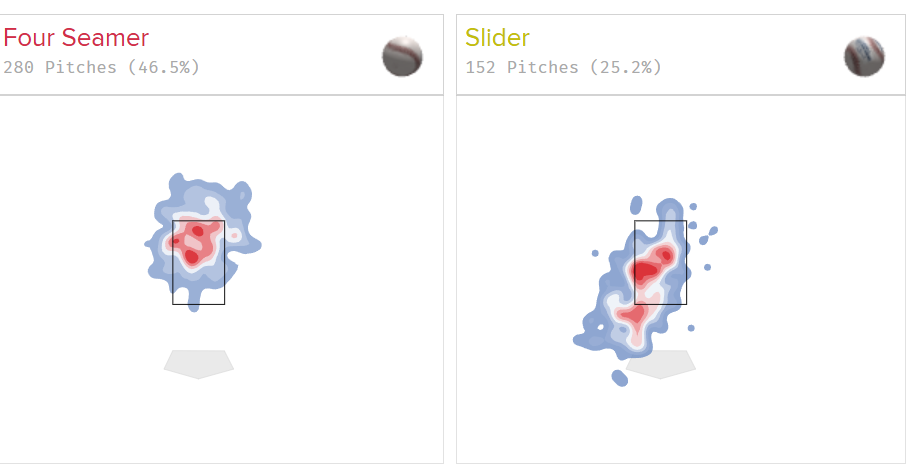Reid Detmers is Finding Success in a New Role
The Los Angeles Angels are reaping the rewards of moving Reid Detmers into the bullpen, as he has become a better pitcher in his new role.

What’s the old saying? Relief pitchers are just failed starters? While that might be true, it shouldn’t take away from their value. How often do we see a good team spoil games due to a bad bullpen? I’m here to shine light on the less glamorous bullpen arms!
When Reid Detmers was drafted in the first-round of the 2020 draft, the Angels thought they were getting a frontline starter. Like many Angels prospects, Detmers was rushed to the majors with up-and-down performances, a few trips to the minors, and plenty of doubt about what he would ultimately become.
After struggling over the past two seasons Detmers was moved to the bullpen prior to this year and has blossomed into one of the few reliable options out of the Angels bullpen. While his 4.50 ERA might not look all that good on the surface, there’s more than what meets the eye.
What’s Changed?
Well, obviously a move to the bullpen. Being pulled from the rotation and only focusing on shorter outings has allowed Detmers to really shine. We often see pitchers velocity jump once they leave the rotation and that has been the case for Detmers.

The biggest velocities jumps have been with his four seamer, slider, and sinker (highlighted above). His slider has jumped from 86.2 mph to 88.1 mph while his sinker has gone from 93.7 mph to 95.3 mph. The improved secondaries are not only helping Detmers become a better pitcher but they are also helping his four seamer play up.
For this exercise, we’ll just call his four-seamer his fastball. Or, you might call it excellent because that’s what it has been. Detmers has quickly established his improved fastball, which has helped propel him to be a much more effective pitcher.
| Fastball | Run Value | Velocity | Whiff% | K% | IVB | BA | SLG |
| 2024 | -7 | 93.8 mph | 24.8% | 24.8% | 17.9 | .234 | .297 |
| 2025 | 4 | 95.3 mph | 34.2% | 34.2% | 18.3 | .275 | .508 |
The velocity jump is not all that uncommon, but this level of change in success is. Although the induced vertical break (IVB), on average, is not much higher, he has grabbed a number of 20s already this season. The better movement is in part due to his change in arm angle over the past two years, where he’s been much less of a side armer and closer to a 45-degree pitcher.
Detmers’ issue in the past was walking too many batters and allowing too many home runs, which snowballed his outing. While the walks are still high, his improved offerings have helped him miss more barrels, allowing only a 7% barrel rate compared to 10.7% last season.
For the first time in his career, he’s limiting hard contact, and his improved movement has allowed more contact to be on the ground with a career-best 44% groundball rate.
All of this to say Reid Detmers is excelling in his new role. A 2.90 xERA, 2.75 FIP, and 3.15 xFIP help to prove it. First, the move to the bullpen was rough, but he has settled in and has not allowed a run in his 11 June outings. Oh yeah, 17 strikeouts across those 10.2 innings.
What’s Next?
As always, when a player completely turns it around we are always asking what’s next?
Will the trend continue, or are we just seeing a hot stretch? Some fans want him moved back to the rotation, although I do not think the same level of success will translate.
To me, Detmers role should not change at all. For the first time in a couple of years he’s found success and finding the best way to continue that success is key. Keeping him in a limited inning role, perhaps where you can strategically use him with an inning heavy with lefties, is the best route.
In terms of improvements, command is at the top of the list. That answer is not solely based on his walk numbers but also his in-zone command.
Obviously, middle-middle pitches are going to lead to the most success for most batters. In terms of pitches in the zone, Detmers has thrown the highest percentage (9%) middle-middle.

As you can see from the heat map above, Detmers is flirting with disaster. His two most frequently used pitches are still living comfortably in a very hittable spot in the zone. While he’s managed to get away with doing so, it could be a ticking time bomb.
Also, what’s next could apply to his future with the Angels. We all know the Angels front office does not operate in the same manner as most, but could Detmers be a trade piece?
He’s in his first year of arbitration and will be under team control through the 2028 season. While a trade isn’t likely, selling high could be possible.
Relievers are always a tricky trade evaluation. Considering his team controls the price might be too high for some contenders who might also favor a more proven asset as a cheaper acquiring cost.
Final Thoughts
Who knows if the success will continue. What we do know is that the Detmers we are currently seeing is the best version of himself. For a guy who’s struggled and had to go back to Triple-A, I’m sure this stretch feels like a huge weight off his shoulders.
Regardless of the Angels plans with Detmers, either moving him back to the rotation, trading him, or giving him more high leverage innings, I’m just glad to see him succeed. Like you often hear, development is not linear. The Angels might have found one of their pieces to help them get back to contention.

